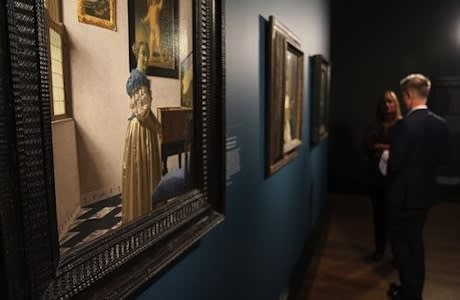Since Johannes Vermeer, an artist perceived as one of the greatest painters of the Dutch Golden Age, has only 34 works universally attributed to him, his show at the National Gallery in London is more of a contextualizing event. Vermeer and Music celebrates his few existing paintings while juxtaposing them with historical information and other portraiture and musical instruments pertaining to music of the time.
How this is laid out and how it presents to a guest visiting the National Gallery isn't entirely clear in the latest of Cineplex's Exhibition series. We're given only fleeting glances of the layout of the show and the handling of space amidst the edifying, albeit clever and concise, discourse provided by Art Historian Tim Marlow and the many curators and writers he interviews about various paintings.
With utmost clarity and well-considered composition, this information piece approaches its subject with a linear timeline. Vermeer's life, mostly shrouded in mystery until recently, is described as provincial, limited to the confines of Holland where he married and had 11 children, yet managed to find enough quiet and stillness to paint. Speculation about his rationale for completing so few works is clearly indicated as such, ensuring that historical fact about his residence and work are prioritized and given meaning primarily by adjacent fact.
The ubiquity of music in 17th Century Holland is discussed at length, as are the many instruments that pop up in Vermeer's work and the inherent seductiveness of the mirrored art forms. Qualifying information, such as the idea that the virginals visible in The Music Lesson, Lady Seated at a Virginal and Lady Standing at a Virginal would have cost more than his paintings help frame the society; one where men and women were traditionally only allowed to intermingle socially within the lexicon of music.
Though the focus shifts to other painters and notions about the cultural climate at the time, Vermeer and Music is careful to step back to the subject at hand at appropriate intervals, fixing on a painting like The Milkmaid or Art of Painting and allowing an expert—someone like Girl with a Pearl Earring author Tracy Chevalier—to discuss his use of light and perspective. That he often uses portraits within portraits to reveal feelings or ideas not necessarily present in the captured mundanity of the image is lost on no one.
Given that the intention is to present a gallery show to a broad audience without stylistic interference, the inherent simplicity in structure and introductory nature of the information is understandable. What this particular Exhibition does well is combine information from influences external to the painter to give a bigger idea of what around Vermeer might influence and aid his work.
Vermeer and Music: The Art of Love and Leisure will screen at select Cineplex theatres across Canada on October 10th and November 3rd, 2013. Encore screenings will be held at some locations on November 23rd, 2013 as well.
(Front Row Centre Events)How this is laid out and how it presents to a guest visiting the National Gallery isn't entirely clear in the latest of Cineplex's Exhibition series. We're given only fleeting glances of the layout of the show and the handling of space amidst the edifying, albeit clever and concise, discourse provided by Art Historian Tim Marlow and the many curators and writers he interviews about various paintings.
With utmost clarity and well-considered composition, this information piece approaches its subject with a linear timeline. Vermeer's life, mostly shrouded in mystery until recently, is described as provincial, limited to the confines of Holland where he married and had 11 children, yet managed to find enough quiet and stillness to paint. Speculation about his rationale for completing so few works is clearly indicated as such, ensuring that historical fact about his residence and work are prioritized and given meaning primarily by adjacent fact.
The ubiquity of music in 17th Century Holland is discussed at length, as are the many instruments that pop up in Vermeer's work and the inherent seductiveness of the mirrored art forms. Qualifying information, such as the idea that the virginals visible in The Music Lesson, Lady Seated at a Virginal and Lady Standing at a Virginal would have cost more than his paintings help frame the society; one where men and women were traditionally only allowed to intermingle socially within the lexicon of music.
Though the focus shifts to other painters and notions about the cultural climate at the time, Vermeer and Music is careful to step back to the subject at hand at appropriate intervals, fixing on a painting like The Milkmaid or Art of Painting and allowing an expert—someone like Girl with a Pearl Earring author Tracy Chevalier—to discuss his use of light and perspective. That he often uses portraits within portraits to reveal feelings or ideas not necessarily present in the captured mundanity of the image is lost on no one.
Given that the intention is to present a gallery show to a broad audience without stylistic interference, the inherent simplicity in structure and introductory nature of the information is understandable. What this particular Exhibition does well is combine information from influences external to the painter to give a bigger idea of what around Vermeer might influence and aid his work.
Vermeer and Music: The Art of Love and Leisure will screen at select Cineplex theatres across Canada on October 10th and November 3rd, 2013. Encore screenings will be held at some locations on November 23rd, 2013 as well.




